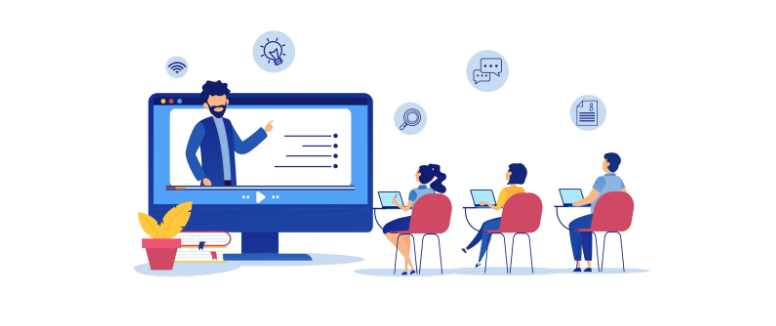
The Virtual Classroom Advantage: Flexibility, Engagement, and Beyond
The advent of virtual classrooms has revolutionized both educational and professional training landscapes, offering a myriad of benefits tailored to the needs of modern learners and professionals alike. By leveraging digital technologies and platforms such as Learning Management Systems (LMS), virtual classrooms provide flexible, accessible, and personalized environments that address many limitations inherent in traditional settings. From reducing costs and environmental impact to expanding course availability and enhancing learner engagement, virtual classrooms are redefining how both educational and employee training experiences are delivered. In this blog, we will explore the key benefits of utilizing virtual classrooms in eLearning and professional development. By understanding these advantages, educators and businesses can effectively harness digital tools to create more inclusive and effective learning experiences, ultimately leading to enriched outcomes for students and employees worldwide.
1. Flexibility and Accessibility
Virtual classrooms, often managed through an LMS, offer unparalleled flexibility, allowing learners and professionals to engage in their courses from any location with an internet connection. This flexibility is crucial for individuals facing geographical, professional, or personal constraints, enabling them to balance education, career growth, and personal responsibilities. Additionally, these platforms include accessibility features such as closed captioning and screen readers, supporting people with disabilities by providing a more inclusive environment. Recorded sessions further enhance accessibility by allowing participants to revisit materials at their convenience, fostering an adaptable and self-paced experience.
2. Cost-Effectiveness
The cost-saving potential of virtual classrooms is significant across both educational and corporate sectors. They eliminate expenses associated with commuting, physical infrastructure, and traditional materials. Educational institutions can reduce tuition fees by minimizing the need for on-site facilities, while companies can save on travel and venue costs for employee training. Access to digital resources also lessens financial burdens on students and employees, making quality education and training more accessible. This digital transformation not only enhances organizational efficiency but also helps maintain a competitive market edge by ensuring consistent employee training quality across global locations.
3. Personalized Learning
An LMS excels in offering personalized learning experiences through adaptive technologies that tailor content to individual needs. This customization ensures each student or employee receives instruction at a suitable level and pace, enhancing comprehension and retention. The ability to control learning speed—pausing, rewinding, or accelerating through materials—empowers participants to take ownership of their educational journeys. Enhanced opportunities for personalized interactions with instructors or trainers, through virtual office hours and specialized feedback, foster supportive and individualized educational experiences.
4. Diverse Educational Tools
The digital nature of virtual classrooms enables the integration of various multimedia tools, making learning richer and more engaging for students and employees alike. Interactive elements such as quizzes, simulations, and videos cater to diverse learning preferences, while collaborative tools like discussion boards encourage active participation and peer-to-peer learning. Innovations like virtual labs and real-life scenarios provide practical, hands-on experiences that bridge the gap between theoretical knowledge and real-world application, applicable in both academic and professional settings.
5. Increased Engagement
Virtual environments can enhance engagement by reducing barriers present in traditional settings. Features like online anonymity, live chats, polls, and breakout rooms empower more reserved participants to actively contribute. The dynamic nature of these platforms allows educators and trainers to employ gamification strategies, making learning more enjoyable and motivating participants to immerse themselves fully in courses and training programs.
6. Environmental Impact
Virtual classrooms contribute to sustainability by significantly reducing education and training’s environmental footprint. The shift away from printed materials reduces paper waste, while the elimination of commutes lowers carbon emissions and energy consumption. The decreased need for physical infrastructure also reduces energy use, supporting environmental conservation efforts and fostering a more sustainable model.
7. Real-Time Feedback and Assessment
The immediacy of feedback facilitated by an LMS in virtual classrooms is valuable for both learners and instructors. Real-time assessments and data-driven insights allow for the quick identification and correction of learning gaps, enhancing understanding and providing instructors with the information needed to tailor teaching strategies effectively. Automated assessment processes enable educators and trainers to allocate more time to delivering personalized feedback and support.
8. Broader Course Selection
A compelling advantage of virtual classrooms is the expanded range of courses and training programs available to participants. Online platforms often collaborate with various institutions and industry leaders to offer programs beyond local offerings, permitting the pursuit of niche interests or specialized fields. Access to courses by global experts enriches learning with diverse perspectives and advanced knowledge, broadening academic and professional horizons worldwide.
In conclusion, the evolution of virtual classrooms through advanced LMS platforms signifies a progressive shift in how education and employee training are delivered and accessed globally. As technology continues to refine and expand the capabilities of virtual learning environments, both the educational and corporate sectors are poised to become more inclusive, efficient, and environmentally friendly. By fully harnessing the potential of virtual classrooms, institutions and organizations can adeptly address present challenges while fostering innovation that significantly enhances educational and professional outcomes. This prepares students and employees alike to meet future demands with confidence and competence.

.svg)









Leave a Reply